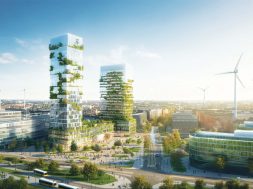Green living
A critical look at today’s sustainable architecture
Green design creates new ways to live and interact with the world, putting thoughtfulness into actions. Green design not only saves energy but also adds luxury. It is far beyond being sustainable. Green design considers the entire life cycle of the building and its components; as well as its social, economic and the environmental impact.
Important characteristics of green architectureGreen architecture is not only sustainable but innovative too. The boundaries of architecture need to be pushed with the new consciousness and awareness. “Sustainable architecture, which is a preferred phrase, will create new ways to live and interact with the world as this awareness grows,” says Ar. Ria Talati, Talati and Panthaky Associated Pvt. Ltd.
According to Ar. Alankrita Soni, “Green architecture is an approach to architectural design that promotes energy efficiency, renewable energy, water conservation, and resource conservation. Green architecture also considers environmental impacts and waste minimisation, creates healthy and comfortable spaces, reduces operation and maintenance costs, and addresses urban issues such as historical preservation, access to public transportation and amenities, community infrastructure systems, social inclusion and safety aspects.”
Achieving sustainability in architectureThe main objective of sustainable design is to reduce depletion of critical resources like energy, waste and raw material. Most important, green design is not just a catchphrase but a belief and an outlook. “Sustainability in architecture can only be achieved once the mindset of the developers and architects changes and also with support and incentives from the government,” explains Ar. Talati. “One is not possible without the other. Once this is achieved to be truly sustainable, the project has to be looked at as a whole from inception to time after it has been occupied.”
For Architect Prem Nath, Prem Nath & Assoc., sustainability is everything that we need for our survival and well being, either directly or indirectly. On our natural environment, sustainability is important to make sure that we have and will continue to have the natural resources to sustain human health and environment.
An architect owns the responsibility to create livable, sustainable development, and it is not just important for a development to be sustainable, but it should also be green.
Architecture that believes in using the power of natural forces like sun, wind, earth and water to create healthy, comfortable habitat for the people is truly sustainable. Today, the ecological crisis and dwindling resources present an urgent need to work out a responsible approach to create, construct and maintain buildings and infrastructure, while minimising negative impact on the environment. Sustainable architecture design plays an important role in addressing these issues.
“Architecture is an indispensable ground for sustainable innovation and an interface among the environmental, economic and socio-cultural dimensions of sustainability in the built environment,” remarks Ar. Soni. “Sustainability in architecture provides a kind of balance between built and un-built environment by blurring lines between indoor and outdoor.”
Sustainable architecture involves considering the entire life cycle of buildings, taking environmental quality, functional quality and future values into account.
Green roofs and IndiaGreen roofs are a relatively new developing movement in architecture in India. Green roofs don’t just mean installing a rooftop garden. Green roofs are the effective strategy for beautifying the building and built environment.
While talking about the origin of green roofs, Ar. Soni describes, “Origin of greening roof surfaces stretch back into the distant past. Some experts believe that the custom of ‘planting hanging gardens on arches or roofs’ evolved as early as 900 BC. The most famous example of green roof and vertical landscaping was created in the 600 BC by Assyrian king Nebuchadnezzar — the famous hanging gardens installed for over parts of the palace in Babylon. The gardens were considered as one of the seven wonders of the ancient world. Many well-known Byzantine and Indian miniature paintings also depict lush roof gardens and patios giving us a rough idea of how widespread the concept of greening the roof surfaces was in the past.”
Green roofs replace a hard infrastructure with one that’s not only more efficient but also beautiful and useful. It is expected that green roofs will find their place on large scale in future, and the green roofing industry is likely to expand in the upcoming years in India.
According to Ar. Nath, “Green roofs are the effective strategy for beautifying the building and built environment. It has lots of benefits like absorbing rainwater, providing insulation, creating a habitat for wildlife, increasing benevolence and decreasing stress of the people around the roof by providing a more aesthetically pleasing landscape and helping lower urban air temperatures and mitigate the heat-island effect.
Controversies on LEED certificationInternationally, voluntary building rating systems like LEED have been instrumental in raising awareness, popularising green design, and improving energy and water efficiency in buildings. There are many controversies on LEED certification, which is criticised for poor model of energy efficiency in India. While talking about the acceptance of LEED in India, Ar. Talati says, “LEED started as a system by people who wanted to establish green building as a viable promising market. They came up with a business-savvy strategy where buildings could be environmentally conscientious and also increase efficiency and decrease cost. It initially made a lot of businesses clamour for its long-term cost-saving and PR potential.”
Even Prof. Anil Laul, Anangpur Building Centre and ASHRA, shares his concern about LEED certification. He explains, “Green rating systems have been created by group of people who don’t understand green. This business is meant only to make up for consultancy. There is panic in the air and the prices of carbon credits have already taken a severe beating, the warning bells have begun to ring. There are many who raise doubts.”
He continues, “With the recent cold waves, the extended winters and increasing blizzards instead of the onset of spring, the battle cry is one of climate change. Not to be caught in a self-contradictory mode, the gurus of green have attributed these near freezing conditions once again, to global warming. The business of selling these alarmist concepts has seen exponential growth in the recent past, and with each successive conclave that sets out to mitigate these challenges, our problems only seem to be spiraling.”
LEED provides very little room to recognise design that goes beyond the scope of its categories. It works well for those looking to check boxes as well as for those genuinely concerned about the environment. Even though the accreditation can be seen as a status symbol, it does also encourage people to make environmentally conscious decisions to get the certification.
As an environmental architect, Ar. Soni believes it is a must to acknowledge that all these rating systems have been really successful in setting targets for raising awareness about sustainable architecture as well as raising the standards of building design and construction. However, Ar. Soni seems hopeful about the future, and he believes that all these rating systems, including LEED, are in their adolescent stage and improving day by day.
Cookie Consent
We use cookies to personalize your experience. By continuing to visit this website you agree to our Terms & Conditions, Privacy Policy and Cookie Policy.









